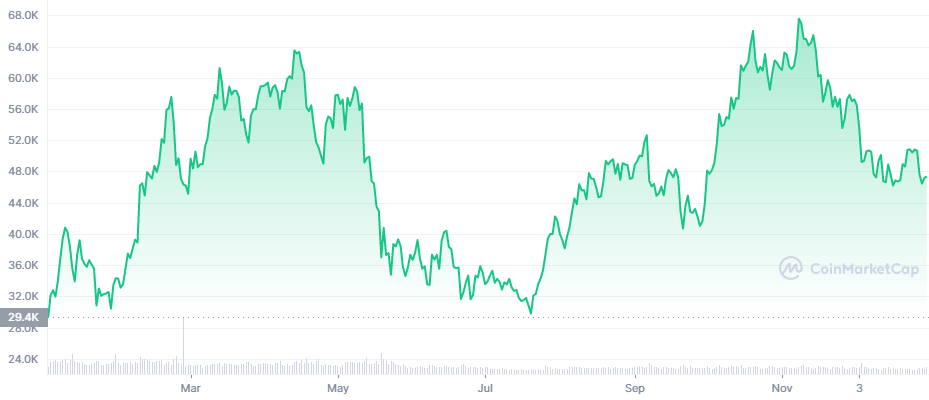MicroStrategy Bought the Bitcoin (BTC) Dip Again

On the day when Bitcoin (BTC) sank toward the $46,900 level, more evidence of corporate buying emerged. MicroStrategy, the most dedicated BTC buyer, once again expanded its holdings. BTC later recovered to $47,424.10 for the last day of 2021.
Binance exchange on-chain analysis shows the company extended its holdings, becoming one of the biggest “whales”. The holdings of MicroStrategy rival the wallets of big exchanges, with the company’s BTC purchases, evaluated close to $300M over time. MicroStrategy has bought BTC at an average price of under $30,000 and intends to hold for the long term.
Binance claims MicroStrategy now owns more than 124,000 BTC. This amount is not the same as the balance of the third biggest wallet, which holds about 120,000 BTC. The wallet, however, is suspected to belong to MicroStrategy.
The significant BTC purchase followed the trend of moving more coins into cold storage to be held as illiquid supply. However, short-term selling is happening at certain points, with signs of corporate buyers cashing out during the May peak and possibly the more recent peak in October.
For some, the selling may also be a signal of a local market bottom, to be abandoned in a rebound in the new year.
BTC Heads for Subdued Year-End
The past year saw BTC revisit twice its peak levels above $65,000. However, the leading coin distanced itself from a widely expected rally with targets above $75,000 and as high as $100,000
The Stock-to-Flow model, or S2F, while invalidated, raises some expectations for continuing on track in the coming year.
In 2021, BTC is headed for gains of around 80%, still underperforming significantly compared to newly arrived altcoins and network tokens.
Will BTC Fears Drag Down Price
BTC trading volumes thinned out in the final days of the year to about $28B in 24 hours. Leveraged positions remain high, despite relatively neutral funding levels. The Bitcoin Fear and Greed Index has fallen back to 22 points or “extreme fear”.
BTC avoided falling under $46,000 and for now renewed its positions. The rejection of $52,000 levels pushed back the recovery, leaving more positive price moves for the coming year.
Despite this, the recent dip sparked new fears of a longer bear market. Now, not only BTC, but altcoins and tokens will have to show if their recent peak levels can hold.
Mainstream Interest Lags for BTC
BTC has gained several forms of investment vehicles to attract mainstream retail investors. The Grayscale GBTC fund now shows lagging demand for the shares, with an equivalent BTC price of $44,500 based on the share price.
Demand for a Bitcoin ETF is still in its beginning, and the next year will show how interest will extend. Currently, the impact of the Canadian ETF in buying physical coins is relatively small compared to the market.
Bitcoin Mining Shifts Balance
The last two quarters of 2021 saw Bitcoin mining shift its balance, after Chinese miners were forced to close some of their farms.
Toward the end of the year, about 35% of mining was concentrated into US farms. For the first time, a US-based mining pool, Foundry.USA, was among the top four block producers. In the past year, miners produced a total of 90% of all BTC to ever be mined as block rewards.
Overall, BTC sending fees remained relatively high, signaling accelerating network usage.
Bitcoin active addresses are at a yearly high, around 894,000 recently used wallets and addresses. Altcoins also show significant growth of new adoption, with wallets growing 100 to 1,000 fold for some of the networks.
The Bitcoin network and cryptocurrency in general was subjected to criticism for its energy usage. The creation of BTC is indeed estimated to use more electricity than a country the size of Austria, though the power usually comes from renewable sources. New proof of stake networks do not need an energy-intensive mining process, though they still require energy usage for cloud infrastructure and using the current Internet pathways.
Ethereum (ETH) Slumps Ahead of Year-End
After a strong quarter, ETH market prices were shaken down again at the end of the year. ETH sank closer to $3,700, pressured by overall low activity during the holiday season.
ETH also sank on signs of coins entering exchanges for potential selling. Despite expectations for levels above $5,000 at the end of the year, or even a trek to $10,000, ETH remained bound in a lower range.
At the same time, more wallets were found holding at least some ETH. The constant growth over the past year market the growing adoption of decentralized trading, open finance and crypto-based gaming. ETH continued to serve as a utility token to pay for the large and unpredictable gas fees.

Uphold makes buying crypto with popular currencies like USD, EUR and GBP very simple with its convenient options to swap between crypto, fiat, equities, and precious metals.

With over 50 coins and an obsession with security, Kraken is one of the safest places to buy and trade crypto.

Kraken has a good reputation for security and protection of your funds and operates across the USA (except NY), Canada, the EU and Japan

Based in Charleston, South Carolina. Serves over 184 countries and has done over $4 billion in transactions. Offers convenient options to swap between crypto, fiat, equities, and precious metals.

What do members of the public think about Crypto in 2021/22? We survey some UK people and look at search data with some surprising results.

From Airdrop to Wallet we look at all the crypto jargon and what it really means

A multi-utility asset, linked to the diverse activities of the Binance Exchange. A token to pay trading fees, as well as participate in new asset sales, BNB now runs on a proprietary blockchain.

An early alternative to Bitcoin, LTC aimed to be a coin for easy, fast, low-fee spending. LTC offers a faster block time and a higher transaction capacity in comparison to Bitcoin.